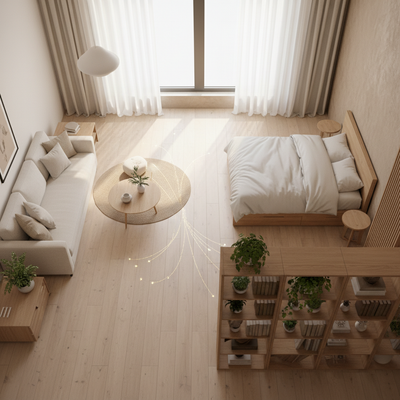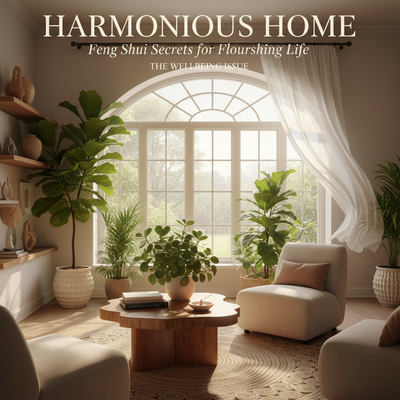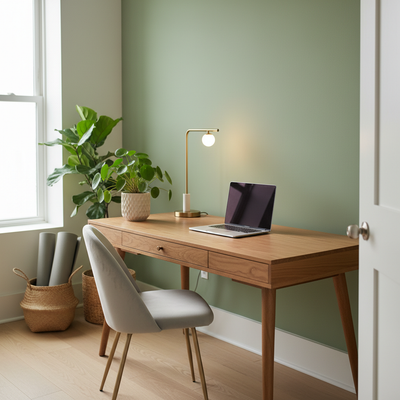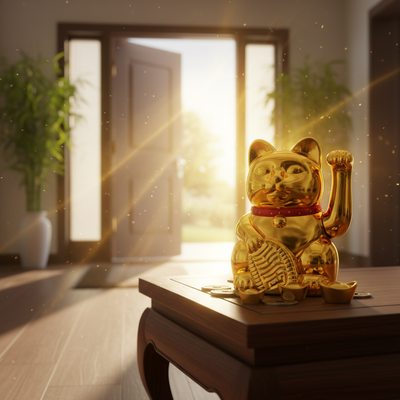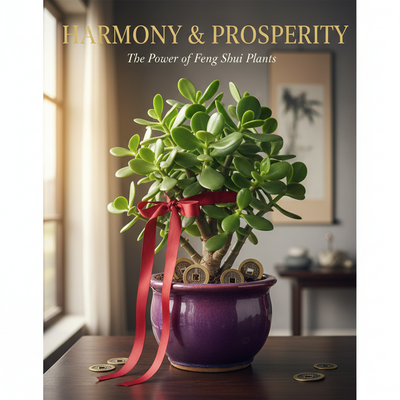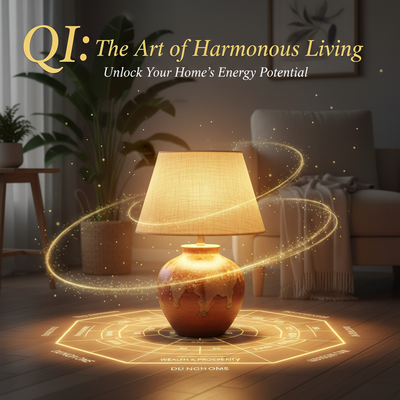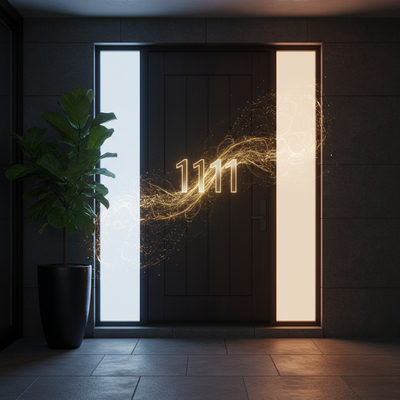More Than a Meal
The dining table is much more than just furniture; it is the center of your home's nourishment. It's where family and friends come together, where bodies and relationships are fed, and where the day's stories are shared. In Feng Shui, this area is an important hub for attracting and moving positive Qi, the vital life force energy that affects your health, wealth, and happiness. A well-chosen dining table can turn mealtimes into a powerful ritual for building abundance and strengthening bonds.
So, what is the best feng shui dining table color? The answer is not one single, universal color. The most powerful and harmonious choice for your home is deeply personal. It depends on three important factors: the specific energy you want to build, the location of your dining room within your home's Bagua map, and your personal Feng Shui element. This guide will walk you through each of these considerations, helping you to select the perfect color to energize your meals and your life.
Understanding Elements and Color

To choose a color with purpose, we must first understand the system that gives it meaning in Feng Shui: Wu Xing, or the Five Elements. This ancient framework explains how energy moves and changes in the universe and, by extension, within your home.
What is Wu Xing?
The Five Elements are Wood, Fire, Earth, Metal, and Water. Each represents a different type of energy and is connected through two main cycles. Understanding these cycles is the key to creating a balanced and supportive environment.
The Productive Cycle describes how one element feeds and creates the next, encouraging growth and harmony.
* Water feeds Wood (like rain on a tree).
* Wood fuels Fire (like logs on a fire).
* Fire creates Earth (as ashes return to the ground).
* Earth produces Metal (as minerals are mined).
* Metal creates Water (through condensation).
The Controlling Cycle describes how elements balance and control each other, preventing any single energy from becoming too strong.
* Water puts out Fire.
* Fire melts Metal.
* Metal cuts Wood.
* Wood breaks up Earth (with its roots).
* Earth blocks Water.
Color and Elemental Energy
In Feng Shui, color is not just decorative; it is a direct expression of one of the Five Elements. Using a specific color is a powerful and easy way to invite its matching elemental energy into your space. For example, introducing the color brown (Wood) can encourage growth and family connection, while using beige (Earth) can improve stability and a feeling of nourishment. This system, a cornerstone of Feng Shui for centuries, provides the basic principles for using color to consciously shape the Qi in your dining area.
Dining Table Color Palette
Here is a complete guide to the colors associated with each element, their meaning in a dining context, and the materials that best embody their energy.
| Element | Colors | Meaning & Energy for Dining | Recommended Materials |
|---|---|---|---|
| Wood | Green, Brown | The Wood element is all about growth, vitality, and family harmony. A brown or green table promotes healing, flexibility, and new beginnings. It is excellent for families looking to strengthen their bonds and encourage a connection to nature. This energy is expansive and kind, encouraging healthy habits and personal development. | Natural wood is the ultimate choice. Oak, pine, walnut, maple, and bamboo all carry strong Wood energy. Live-edge tables, with their organic shapes, are particularly powerful for bringing natural vitality indoors. |
| Fire | Red, Strong Orange, Purple, Pink | Fire is the element of passion, celebration, and high energy. Using these colors in a dining area ignites lively conversation, promotes recognition, and creates a festive atmosphere. However, Fire energy is powerful and should be used with intention. A full red table can be over-stimulating, potentially leading to arguments or rushed eating. | Fire is best used as an accent. Consider red placemats, a floral centerpiece with pink or purple blooms, or artwork. If you desire a Fire element table, a deep, rich wood with a reddish hue can work, but painted tables in these colors are rare for a reason. |
| Earth | Light Yellow, Sandy/Earthy Tones, Beige, Taupe | Earth is the element of stability, grounding, and nourishment. These colors create a sense of security, support, and belonging. An Earth-toned table encourages a calm and centered dining experience, strengthening relationships and promoting physical and emotional health. It makes the dining room feel like the true, stable heart of the home. | Solid, heavy wood in a light or natural finish works well. Stone tables, such as travertine or light-colored granite, are powerful expressions of Earth energy. Ceramic-topped tables also carry this grounding quality. The key is a sense of weight and stability. |
| Metal | White, Gray, Metallic Hues (Gold, Silver, Bronze) | The Metal element brings clarity, precision, efficiency, and joy. A white or gray table encourages focus, order, and clear communication. It is excellent for modern or minimalist styles and can make a space feel clean and uncluttered. Metal energy supports intellect and financial management, bringing a sense of refinement to the dining experience. | Tables with metal bases or legs are a direct way to introduce this element. White-lacquered or light gray painted wood tables are also excellent choices. A table with subtle metallic inlays can add a touch of sophisticated Metal energy. |
| Water | Black, Dark Blue | Water represents wisdom, introspection, and social flow. It is also deeply connected to career, life path, and abundance. A black or dark blue table can create a sense of depth and sophistication, encouraging deep conversations and a smooth flow of social connections. It helps energy and wealth circulate freely within the home. | Black or dark blue stained wood can be very elegant. A glass top is the most common representation of the Water element, symbolizing clarity and flow. However, ensure it has a sturdy, substantial base to provide grounding and prevent a feeling of instability. |
Choosing the Right Color
Now that you understand the elements, you can move beyond a simple chart to a more personalized decision. This three-step process will help you select the color that is uniquely right for your home and your intentions.
Step 1: Identify Your Intention
First, ask yourself what you want to build in your life and during your mealtimes. The dining table is a powerful tool for manifestation. What energy does your family need most right now?
- Do you want more family harmony and connection? To encourage growth and reduce tension between family members, focus on the Wood element. A brown wood table is a classic and powerful choice.
- Are you hoping for more lively dinner parties and social recognition? If your goal is to be a vibrant host and create excitement, introduce the Fire element through accents on or around your table.
- Do you wish to attract more financial abundance and opportunity? The Water element (black, dark blue) is directly tied to cash flow and career. The Wood element (brown, green) also supports wealth, as it represents growth.
- Are you seeking more stability, better health, and a stronger sense of security? The Earth element (beige, sandy tones, light yellow) is your greatest ally. It grounds the home's energy and nurtures its inhabitants.
Step 2: Locate Your Dining Area
Next, determine where your dining area falls on the Bagua map, the energy grid of your home. To do this, stand at your front door looking in and overlay a 3x3 grid over your home's floor plan. The area you are standing in is the front-center square (Career).
The color you choose should ideally be in harmony with the element of the Bagua sector your dining table occupies. Use the Productive Cycle to select a color that either matches or nourishes the area's native element.
- East (Health & Family, Wood Element): A brown (Wood) or black (Water nourishes Wood) table is excellent here.
- Southeast (Wealth & Prosperity, Wood Element): Brown (Wood) or black (Water) tables are ideal for activating abundance.
- South (Fame & Recognition, Fire Element): A brown (Wood nourishes Fire) table is a great choice. Avoid black or blue (Water) tables here.
- Southwest (Love & Relationships, Earth Element): An Earth-toned (beige, yellow) or Fire-accented (reds) table works beautifully.
- West (Children & Creativity, Metal Element): A white or gray (Metal) or an Earth-toned (Earth produces Metal) table is perfect.
- Northwest (Helpful People & Travel, Metal Element): Choose white, gray, or an Earth-toned table to enhance this energy.
- North (Career & Life Path, Water Element): A black (Water) or white/metallic (Metal produces Water) table is optimal.
- Center (Health & Unity, Earth Element): An Earth-toned table is the best choice to stabilize the entire home.
Step 3: Consider Your Kua Number
For those who want to take their Feng Shui to the next level, consider your personal Kua number. This number, derived from your birth year and gender, reveals your personal lucky and unlucky directions and, most importantly, your personal Feng Shui element.

By choosing a feng shui dining table color that supports the element of the family's primary breadwinner, you can provide an extra layer of support for their success, which benefits the entire household. You can find your Kua number using an online calculator. Once you know your element, you can use the Productive Cycle to choose a supportive color. For instance, if the breadwinner is a Fire element person, a Wood (brown) table would be an excellent choice as Wood fuels Fire. This is an optional but powerful layer for fine-tuning the energy of your space.
A Real-World Example
Feng Shui principles can feel abstract, but their effects are real. We often see significant shifts in our clients' lives after making simple but targeted changes.
The Disconnected Dining Room
A family recently contacted us after moving into a new home. They felt their mealtimes were rushed and disconnected. Their dining room, which they had furnished with a stylish but stark white metal-and-glass table, felt cold and uninviting. This feeling was showing up as minor but persistent arguments during dinner, and a general sense that no one wanted to stay at the table.
The QI FLOW Solution
When THE QI FLOW team was brought in for a consultation, our analysis quickly identified the issue. First, we determined that the dining room was located in the family's 'Wealth and Prosperity' area (Southeast), which is a Wood element sector. The existing table was a combination of Metal (the white frame) and Water (the glass top). In the Five Element cycle, Metal cuts (controls) Wood, and while Water nourishes Wood, the overwhelming coldness of the Metal was draining the nurturing energy of the space. The glass top also created a sense of instability, as if the energy of the food and conversation was falling right through.
Our team recommended replacing the table with a solid, round oak table. The brown color and wood material (Wood Element) directly nourished and strengthened the Wealth area. We specifically suggested a round shape to promote a better, more equal flow of Qi and conversation, ensuring everyone at the table felt equal and included.
The Harmonious Result
Within weeks of making the change, the clients reported a dramatic shift. Mealtimes became a cherished daily ritual for connection and sharing. They told us the room felt warmer and more welcoming, and the family felt more grounded and supported. As a direct result of activating their wealth corner with the correct element, they also noted several unexpected positive developments in their finances. This story is a perfect example of how a dining table is not just furniture; it's an active tool for shaping your family's harmony and abundance.
Beyond Color: Key Factors
While color is a primary tool, it works together with other factors. For a truly harmonious space, consider these aspects of your dining table as well.
The Power of Shape
- Round/Oval: These are considered the best shapes for a dining table in Feng Shui. The lack of sharp corners allows Qi to flow smoothly and freely. It promotes equality and encourages conversation, as everyone can see and engage with each other easily.
- Square: A square table represents the Earth element and promotes stability and order. However, its sharp corners can create "poison arrows" or cutting Qi, and the rigid seating can feel formal and less conducive to flowing conversation.
- Rectangular: The most common shape, a rectangular table creates a clear hierarchy, with those at the "head" of the table holding the most authority. This is good for large families or formal dining, but can feel less intimate than a round table.
The Message of Material
- Wood: As discussed, wood brings the energy of growth, family, and kindness. It is a warm, supportive material that is almost always a good choice.
- Glass: Representing the Water element, glass can feel modern and light. However, it can also feel unstable, as if the energy of the food is not being held. If you choose glass, ensure it has a very sturdy, solid base (wood or stone) to provide grounding.
- Stone/Marble: These materials carry strong Earth energy, making them grounding and stable. They can feel very luxurious but may also feel cold and hard, which is not always conducive to long, relaxed meals. Use warm-colored placemats to balance this.
- Metal: Metal brings precision and clarity. Like glass, it can feel cold and "sharp" if it is the dominant material. It's often best used as a base or accent rather than the entire tabletop.
The Importance of Placement
Finally, where you place your table matters. Ideally, your dining table should not be in a direct line with the front door or a bathroom door, as this can cause Qi to rush away too quickly. Ensure diners, particularly the heads of the household, have a solid wall behind their backs for support. And lastly, make sure the area is well-lit with a beautiful fixture to lift the energy and properly illuminate the food you are sharing.
Colors to Use Cautiously
Just as some colors can enhance your dining experience, others should be used with caution as the primary color for a large dining table.
- Too Much Black: While black represents the Water element and can symbolize abundance, an entirely black dining table can feel oppressive, heavy, and depressing. It absorbs light and energy, which can dampen conversation and appetite. It is far more effective when used as an accent, such as in the chair legs or a table base, balanced by a lighter top.
- Stark, Clinical White: White is a Metal element color that represents purity and clarity. However, a very stark, glossy, clinical white can evoke the feeling of a hospital or laboratory. This sterile energy is not conducive to relaxing, enjoying food, and nurturing relationships. If you love white, opt for softer off-whites, creams, or a matte-finish natural wood painted white.
- Overly Bright or Chaotic Colors: The dining experience should be calming and nurturing. A table with jarring, overly stimulating patterns or a neon color can create chaotic Qi. This can lead to a feeling of restlessness, indigestion, and even arguments. Save these high-energy expressions for accent pieces or rooms dedicated to more active pursuits.
Crafting Your Abundance
Your dining table is a powerful anchor for the energy of your home. Choosing its color is not a trivial design decision; it is an act of intention. By thoughtfully considering the energy you want to build, the unique layout of your home, and the foundational principles of the Five Elements, you can select a table that does more than just hold your plates. You can create a vibrant center of abundance, a place that truly nourishes your family, strengthens your bonds, and fills your home with harmonious, life-giving Qi.
